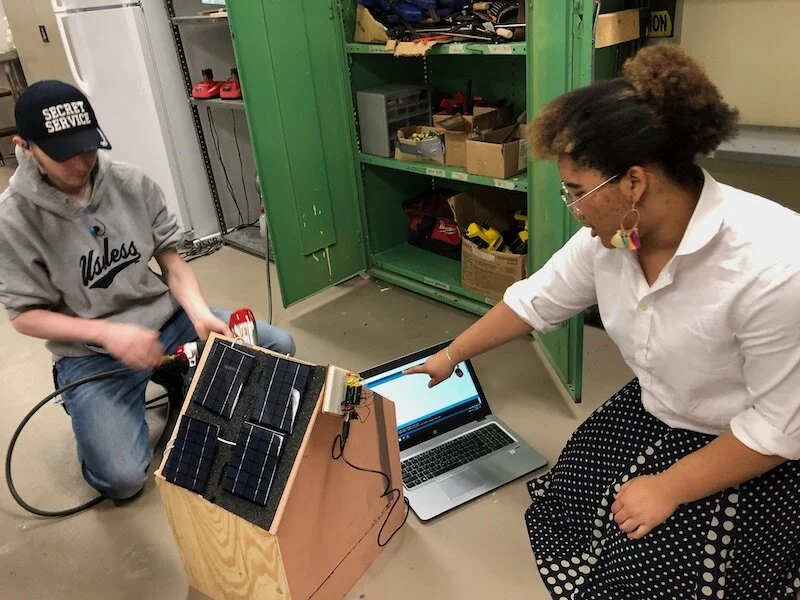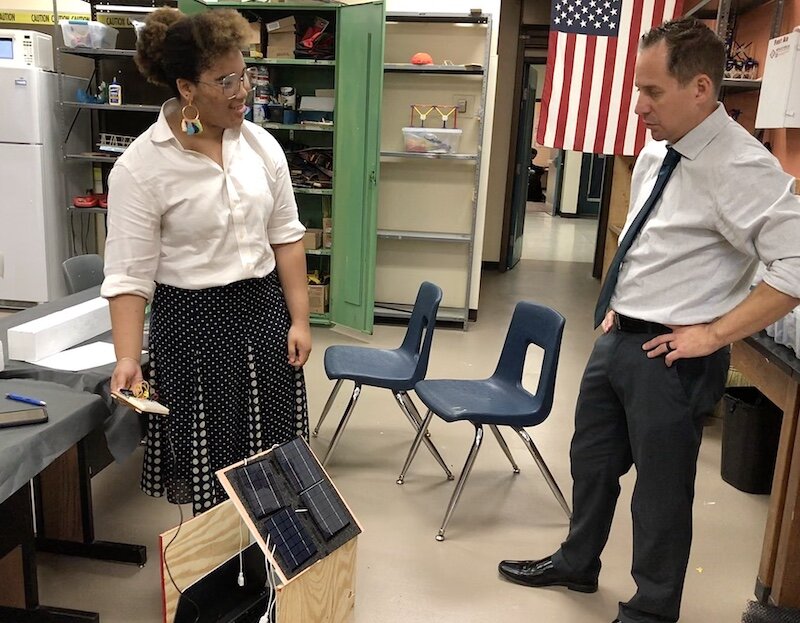Powerful Study of Careers in Solar Energy
Engineering students at the National Inventors Hall of Fame STEM Academy in Akron tweak their house designs as they prepare presentations for professionals at their business partner, SUNation.
Students work collaboratively to design and build models of a solar paneled home through an intensive project that teaches science content along with 21st century life/career skills.
“It’s always about career exploration, collaboration, and using technology. Those are the three biggies in every project we do.”
-Zachary Griffith, engineering teacher, NIHF STEM Academy, Akron
Last fall, through a hands-on PBL, students at Akron’s National Inventors Hall of Fame STEM Academy experimented with solar energy to decide if they have a passion for the subject and might be interested in pursuing a career in the field.
“Our job is to help students explore a topic, discover if they like, and determine if they want to learn more about it,” explained Zachary Griffith, engineering teacher at the district’s STEM high school. With a Grant-to-Educators from the Jennings Foundation, Mr. Griffith designed a PBL experience that challenged students to research, design, and build models of an energy efficient solar paneled house. SUNation, a solar energy company located in New York state, agreed to partner with the students throughout the study.
“Solar is the next big, up-and-coming career field because of its booming opportunities not only in the local area but nationally and worldwide,” Mr. Griffith said, explaining that he had preliminary conversations with professionals at SUNation while developing the project. “We decided it would be great if the kids explored the entire process – how solar panels are configured, how they are tested, how they are installed, how they are marketed and sold -- so they could experience the entire process to see if they would like to do that for a career.”
Learning how to work with customers would be another important aspect of the project. Practicing how to educate customers about a specific product and then providing customers with a service/product that meets their needs is valuable experience for any future business venture. Finally, the students would create a multimedia presentation to describe and demonstrate their work.
Early in the project, students created a chart detailing what they know, what they need to know, and strategies that will lead them to a solution. The chart guided their work throughout the entire process.
The Essential Question
Through a live stream, engineers at SUNation met with Mr. Griffith’s students at the project’s onset to present them with an environmental problem: How can you use solar cells efficiently to power a residential building? The goal is to save energy for homeowners. Students responded by developing a chart detailing 1) what they know; 2) what they need to know; and 3) possible strategies that would to lead them to a solution. From that initial meeting, students formed design teams, each working to develop its own solution to the problem. Individuals within the team assumed specific roles typical in a real-world workplace. This included a project manager, the ‘backbone’ of the group who coordinated all aspects of the project, evaluated costs, and made sure other members stayed on task; a technician, who was responsible for constructing the 3D model; and a media specialist, who created a video presentation to share with SUNation that would explain the team’s design and how it achieved the intended results. The professionals would then offer valuable feedback and highlight the most efficient design.
Research, Data Collection and Analysis, Reflection
Research guided each team as they configured how best to angle their house on a given property, keeping local building codes in mind, and position the solar panels to maximize energy production. (There were also very specific academic targets involved that aligned with state standards on solar energy.) They measured voltage levels, made adjustments, and improved upon their designs to achieve the best results. One team manager pointed out a computer program that figured with an initial investment of $6,000 in solar panels, a homeowner could save $17,000 on average energy expenses over 10 years.
In addition to outfitting a house for typical energy usage, the original problem required students to develop “add ons” – extra objects associated with residential living that that could also be powered by the sun. One team designed small, portable solar panels to energize twinkling lights to illuminate a patio after dark. Another group devised a way to heat the floors throughout the home and provide residents with fuel for a secondary hot water tank.
Team members collaborate to test, evaluate, and reconfigure their model — important “trial and error” steps involved in any engineering design task.
Student Engagement
“What I like about the project is that I have a lot of freedom in building my model,” remarked one construction technician. “I don’t like being tied down to specifics, especially in an environment like this where you discover new criteria all the time that may change how something works. There is a lot of critical thinking and a lot of problem-solving involved.”
Another student said the most important lesson she learned as project manager is to be resilient. “If we do something wrong, we have to redo it,” she remarked. “You can’t get frustrated with that. You just have to keep going and roll with the punches.”
Mr. Griffith continued the discussion noting how the project contributes to the students’ deep learning: “This is not a ‘recall’ experience,” he explains. “There is a research component where students learn about and discuss solar energy, but then there is a ‘beginning to end’ analysis and a presentation package afterwards explaining how solar energy works. They have a customer, they have constraints, and they have career exploration. All three of those are on the Depth of Knowledge chart – that’s what we are doing here.”
One team’s project manager consults with Mr. Griffith on how to improve the efficiency of the team’s model the day before making a presentation to SUNation.
While this particular PBL focused on alternative energy, a field that may not appeal to all students, Mr. Griffith knows his students will take away valuable knowledge, not only about the subject matter but also about themselves, that applies to any career choice: “I want them to know that they are never alone, that they are always part of a team, that there are always resources available to help them, and that they should always be trying out new careers to see what they like.
“It doesn’t matter what career path they ultimately choose,” he adds. “What matters is that they have the skills they need, they have a passion for it, they have the academics they need, and they have experiences so that they can make an informed decision about their future.”






